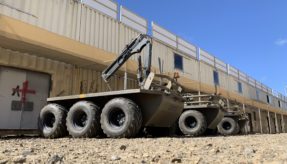
Often referred to as ‘the last mile’, the final stage of supplying equipment to troops on the front line in challenging environments can be a lengthy and dangerous process. Here, Steve Fitz, Director of Technology at Plextek Ltd, examines some of the solutions to the challenge.
Resupplying frontline soldiers with mission-critical equipment can be a difficult and risky undertaking, especially in the so-called ‘last mile’. This area, close to the front line, could be contested, is unlikely to be under complete control and may contain threats such as Improvised Explosive Devices (IEDs), snipers and even residual enemy determined to disrupt the resupply.
It therefore makes sense to have the ability to use autonomous platforms for this operation: Unmanned Ground Vehicles (UGVs) or Unmanned Air Vehicles (UAVs). Such use of autonomous vehicles not only reduces the risk to and burden on military personnel but also improves the efficiency and pace of frontline resupply, enabling more agile and responsive military operations in complex environments.
A UGV has the advantage that it can carry heavy payloads and travel for long distances. However, the terrain could be complex and unstructured; achieving autonomous navigation in such environments is a daunting technical challenge. The parallel problem of autonomous cars, which benefit from structured roads, accurate maps, mind-blowing levels of investment and (perhaps) a lack of deliberate disruption, nevertheless struggles to provide a viable solution with today’s technology. A UAV, while limited by payload size and endurance, sees a much less complex world from altitude and is more difficult for an enemy to attack or disrupt.
Although the world looks less complex for a UAV than for a UGV, there are nevertheless hazards that UAVs need to ‘sense and avoid’, especially as operational environments may include urban settings. These hazards include high buildings, telegraph wires and rapid changes in terrain height. Safely navigating through an urban canyon and then landing the platform so that it can be unloaded is a challenge. It is unlikely to be enough to rely on accurate mapping and precise localisation (eg GPS) to avoid collisions; on-board sensors will be needed that can augment or in some circumstances replace these methods. Current approaches use camera and lidar sensors (in visible and/or non-visible bands) to develop a ‘view of the world’ from which the platform can route-plan. Neither of these sensors provides an all-weather day/night capability and the processing needed to create a useful geometric input for navigation can be onerous.
Plextek, an electronics design house based in the Cambridge area, is developing a radar operating at mm-wave frequencies (in this case 60-90 GHz). Steve Fitz, Director of Technology at Plextek Ltd, explained: “The great benefit of working at such a high frequency is that compact antennas can nevertheless provide the spatial resolution to support autonomy; the air platform may not need to see a target in exquisite detail or at least other sensors can provide that detail, but it must always detect an object that it can collide with and know with certainty its geometry. This is the essential input to robust autonomous navigation. This ability of the radar extends to targets that are easy to miss with other sensors such as overhead wires, streetlamps, fences, aerials and even other autonomous platforms.”
Mr Fitz continued: “Working with COTS SiGe chipsets we are able to engineer a low-cost, small-footprint sensor that can provide a capability complimentary to camera and lidar sensors, increasing the robustness with which the platform can safely navigate its environment.
“Crucially, the radar can further add to resilience by continuing to operate in adverse weather conditions, such as rain, fog and dust, where other sensors are greatly impaired.”
Plextek has recently been awarded a contract by the Defence Science and Technology Laboratory (Dstl), under a Defence and Security Accelerator competition, to assess the benefits that mm-wave radar technology will provide to support the autonomous operation of UAVs and UGVs for frontline resupply.
Mr Fitz concluded: “The project will allow Plextek to demonstrate the performance of the radar in detecting the various hazards that autonomous platforms are likely to encounter, in addition to understanding how best to integrate mm-wave radar technology with autonomous platforms, including from mechanical, electrical and software perspectives.”
The project will culminate with a demonstration of a mm-wave radar integrated with a UAV to support fully autonomous operation in complex environments.
For more information, visit: www.plextek.com
If you would like to join our community and read more articles like this then please click here.
Autonomous resupply Plextek Steve Fitz the last mile Unmanned Air Vehicles Unmanned Ground Vehicles







